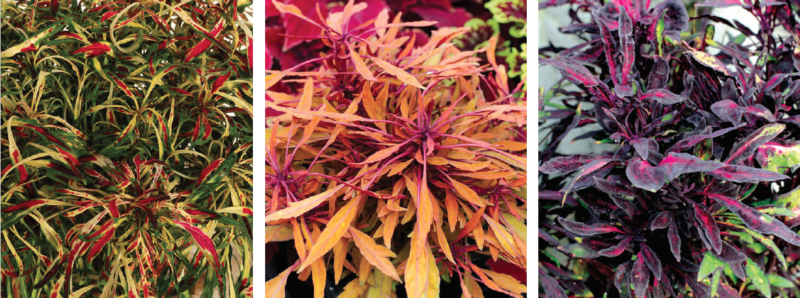
Culture Report: Coleus Fancy Feathers Series
Do you remember the first time you saw a coleus? Your eyes could hardly believe the amazing combinations of colors, spots and splashes. Coleus were hot in the 1960s and were pushed aside for other new varieties and cutting-grown annuals.
Well, guess what? Millennials are attracted to houseplants and are blown away by the colors of coleus. It is one of those plants that can act as a vital bridge from the indoors to the outdoors.
Terra Nova Nurseries is a company whose name is synonymous with innovation. With coleus (or solenostemon or plectranthus), our goal was to provide a range of colors that was heat tolerant, looked different and was extremely low maintenance. At Longwood Gardens, I overheard a maintenance worker complaining that it was the fourth time they had to cut ‘Wasabi’ back. As the industry has seen with the sweet potato vine, plants can be too vigorous. Thus, Terra Nova’s breeders used “self-branching with no need for PGRs” as a breeding aim. With Fancy Feathers, that goal was achieved with unique foliage and strong self branching.
In the early 1960s, Coleus was a seed crop with very limited color range. Hanging varieties were known, but limited and some strains were cutting propagated, mostly by enthusiasts. Due to virus susceptibility, many forms disappeared. The 1980s had a partial renaissance as cutting-grown varieties were being bred, especially at the University of Florida. Through the breeder’s hands of Gary Gossett, Rob Jansen, current breeder Chuck Pavlich and a prominent (now deceased) breeder from Wisley, UK, a group of plants have been developed to fill the many niches between small patio plants to exuberant hanging baskets. Blooms are discouraged on breeding results as they are another maintenance factor, can look quite ugly, and form an attractive base for Botrytis as they decay.
Out of this work came the Fancy Feathers collection, featuring plants with small to medium mounding habits. These do well in full or partial shade in southern climates and partial to full sun in northern climates. They are USDA rated at 10 to 11. The collection features a range of rich-colored foliage with attractive, feathery foliage, super branching and few flowers.
These new varieties are ideal for single or group plantings in the landscape as a tight border, or in planters, providing long-lasting foliage color to brighten up the summer palette. These plants form a mounding tuffet and look adorable in a 4-inch pot or can fill a 10-inch container. Ultimate plant height is 10 inches with a 23-inch spread.
AVAILABLE COLORS AND RECOGNITION
Three colors are available: Pink, Black and Copper. The entire collection won the Retailer’s Choice Award at Cultivate’17. ‘Fancy Feathers Copper’ was Top Performer in the 2016 Kansas State University Trials as Under the Sea ‘Sea Urchin Copper’. It also won Best of the Rest at the University of Georgia trial garden in 2017.
PROPAGATION
Fancy Feathers are available as cuttings from clean tissue cultured mother plants. (All coleus are very prone to viral diseases like INSV so in-house propagation is discouraged). Begin feeding at 75- to 100-ppm nitrogen maintaining an EC between 1 and 2. We recommend using a low-phosphorus, calcium nitrate-based fertilizer to provide adequate nutrients without promoting the soft, stretchy growth seen under an ammonia-based fertilizer programs.
FINISHING
Use a well-drained soil mix with a pH of 5.8 to 7.0. Directly after transplanting, slightly warmer temperatures will promote rapid growth and root development. After 10 to 18 days, optimal growing temperatures are 65 to 75° F days and 62° F nights.
MEDIA AND FERTILIZATION
Allow the soil to dry out between waterings to promote healthy root development. Overly moist soil conditions may create favorable environments for fungal and bacterial pathogens to colonize. Drier conditions will also help reduce petiole and internode stretch. Soils with excellent drainage and lower peat content are recommended. Maintain an optimal root zone temperature of 65 to 70° F. Fertilize at 100- to 150- ppm nitrogen using a balanced feed (14-10-20 is advised) to maintain foliage color. They are moderate feeders.
Fertilizers containing a low percentage of ammonium and urea are recommended to reduce internode and petiole stretch. Irrigate occasionally with clear water to help eliminate salt build- up. An optimal EC for finishing is 1 to 2.
PINCHING AND GROWTH REGULATORS
Pinching is not necessary. The Fancy Feathers collection is self-branching, making PGR applications unnecessary and even destructive to the plant form.
INSECTS AND DISEASES
Aphids, thrips and fungus gnats are the most prevalent pests, particularly during propagation. Thrips are worst at flowering time (nice that they don’t flower) and aphids during summer growth.
Allowing soil to dry out between waterings and avoiding sending plants into their night cycle with water on the foliage will tremendously reduce diseases like Phytophthora and pest pressure. Botrytis can occur with ideal conditions of high humidity and cool temperatures. Scouting for any issues along with a preventative drench and spray program should help prevent most pest infestations and diseases.
More info can be found at www.terranovanurseries.com/product-category/plant-series/coleus-fancy-feathers-collection.


 Video Library
Video Library 




















